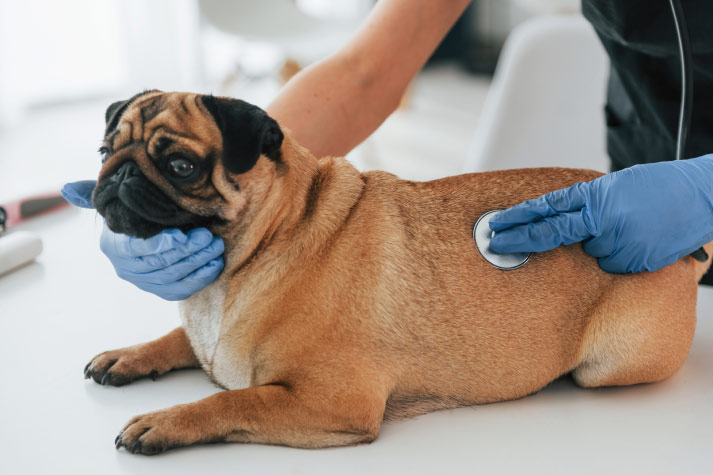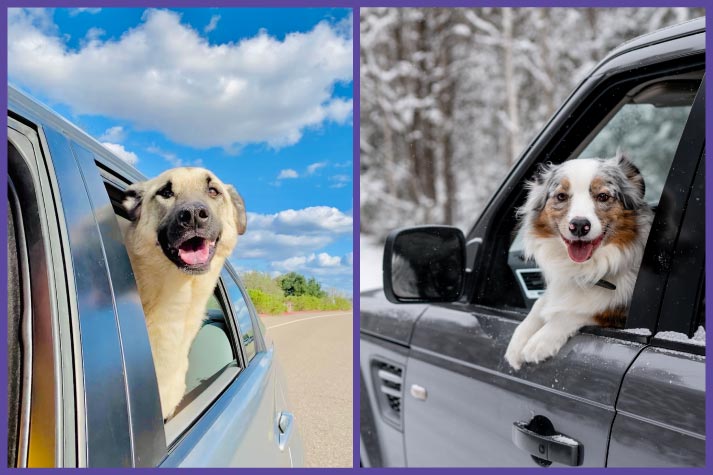
17 Mar
How to Recognize Dehydration and Heatstroke in Dogs
As temperatures rise, it's essential for dog owners to be aware of the dangers of dehydration and heatstroke. Both conditions can be life-threatening if not addressed promptly. Understanding the signs, causes, and prevention methods can help you keep your furry friend safe during hot weather.
What is Dehydration?
Dehydration occurs when an animal loses more fluid than it consumes, leading to a deficiency that affects nearly every function in the body. In dogs, water plays a crucial role in maintaining body temperature, aiding digestion, circulating oxygen in the blood, and supporting overall health. Without enough water, a dog’s body cannot perform these essential tasks, putting them at risk of serious health problems.
Why is My Dog Dehydrated?
The main cause of dehydration in dogs is a simple imbalance between water intake and fluid loss. This can happen when your dog doesn't drink enough water, especially in hot weather or after intense exercise. Dehydration can also result from vomiting, diarrhoea, or certain illnesses that cause excessive fluid loss. Sometimes, a dog's personality plays a role; some dogs are picky drinkers and may only drink when prompted by their owners. Highly active breeds may deplete their fluid reserves quickly through strenuous activities like running, playing, or working.
How to Tell if Your Dog is Dehydrated
Dogs can’t tell us when they’re feeling unwell, so it’s up to their owners to spot the signs of dehydration. Recognizing these symptoms early can prevent severe complications. Look out for the following signs:
- Vomiting: Often accompanied by a lack of appetite, vomiting can quickly lead to fluid loss.
- Loss of Appetite: Dehydrated dogs may refuse to eat, further aggravating their condition.
- Lethargy: Dehydrated dogs often appear tired, sluggish, or uninterested in their usual activities.
- Dry Nose and Gums: A dog’s nose and gums should be moist; if they appear dry, this is a warning sign.
- Loss of Skin Elasticity: Gently pinch the skin on the back of your dog’s neck or between the shoulders. If it doesn’t snap back quickly, your dog may be dehydrated.
- Sunken or Dry-Looking Eyes: Dehydration can cause the eyes to appear sunken and less bright than usual.
If you notice these signs, ensure your dog has access to fresh water immediately and monitor their condition closely. Severe dehydration may require veterinary attention.
What is Heatstroke?
Heatstroke is a severe condition that occurs when a dog’s body temperature rises above 40.5°C (105°F). This usually happens in hot or humid conditions, especially when a dog is unable to cool itself adequately. Heatstroke can lead to organ damage, collapse, and in extreme cases, death.
Dogs primarily cool themselves through panting, which helps dissipate heat by evaporating moisture from the tongue and respiratory tract. However, unlike humans, dogs don’t sweat efficiently, except for minimal sweating through their paw pads, which is not enough to regulate body temperature in extreme heat.
Why Does My Dog Have Heatstroke?
Heatstroke is typically triggered by hot and humid weather, but there are several contributing factors:
- Age and Health: Puppies and senior dogs are more susceptible due to their less efficient body temperature regulation. Dogs with health conditions, such as heart disease or obesity, are also at higher risk.
- Physical Condition: Overweight or out-of-shape dogs have a harder time staying cool and are more likely to overheat during exercise or in hot conditions.
- Hot Environments: Leaving a dog in a hot car, even for a short period, is one of the leading causes of heatstroke. Similarly, exercise in extreme heat can push a dog beyond its limits.
- Dehydration: Not drinking enough water can quickly lead to overheating, as dehydration impairs a dog’s ability to regulate body temperature.
- Sudden Environmental Changes: Dogs not accustomed to hot climates may struggle to adapt, putting them at risk of heatstroke.
- Breed-Specific Susceptibility: Some breeds, particularly those with flat faces (like Bulldogs and Pugs), struggle more with heat due to their restricted airways, making them more vulnerable to heatstroke.
How to Identify and Treat Heatstroke in Your Dog
Heatstroke is a critical emergency that requires immediate attention. It can cause severe dehydration, hyperventilation, and a dangerous drop in blood pressure, which can be life-threatening if not managed quickly. Here are the symptoms to watch for:
- Rapid Breathing or Hyperventilation: Excessive panting or difficulty breathing is a clear sign of overheating.
- Dilated Pupils and Bright Red Gums or Tongue: These are signs of excessive heat and increased blood flow.
- Increased Heart Rate: Check your dog’s pulse by placing your hand on their chest. A rapid heartbeat can indicate heat stress.
- Hot Skin: A dog suffering from heatstroke will feel unusually warm to the touch, especially on their ears and paws.
- Hyperactivity or Disorientation: Some dogs may become overly active, disoriented, or unsteady on their feet as their body struggles to cope with the heat.
What to Do if Your Dog Has Heatstroke
If your dog shows signs of heatstroke, immediate action is essential. Move them into a shady area and immediately follow these steps:
- Move to a Cooler Area: Quickly get your dog to a shaded or air-conditioned location.
- Cool Them Down: Use cool (not cold) water to wet their body with a sponge, towel, or spray bottle. Avoid ice-cold water as it can cause shock.
- Fan Them: Use a fan to help with evaporation and cooling.
- Offer Water: Provide small sips of water, but do not force them to drink.
Heatstroke can cause lasting damage, so prevention is always better than cure. Keep your dog hydrated, avoid excessive exercise in the heat, and never leave them in hot, confined spaces. By staying alert to the signs of dehydration and heatstroke, you can help ensure your dog stays healthy and safe, no matter how high the temperature climbs.






AUTHOR’S BIO
Carry My Pet
Passionate pet enthusiasts and globetrotters, dedicated to easing furry friends' journeys worldwide. Penning tales of compassion at CarryMyPet, where every relocation is a tail-wagging adventure.